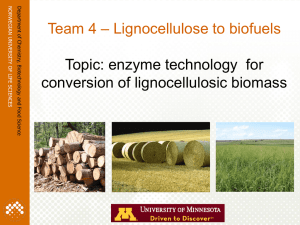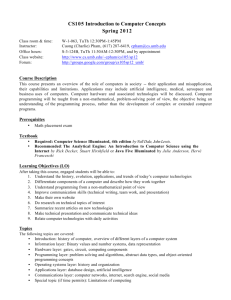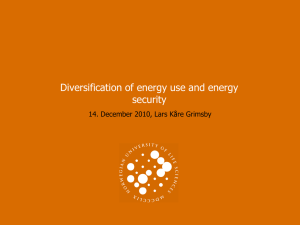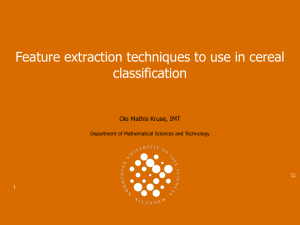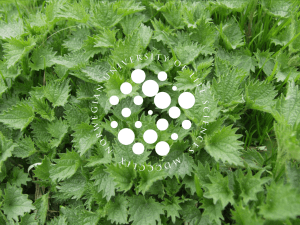Introduction to natural systems - soil infiltration, wetlands, ponds
advertisement
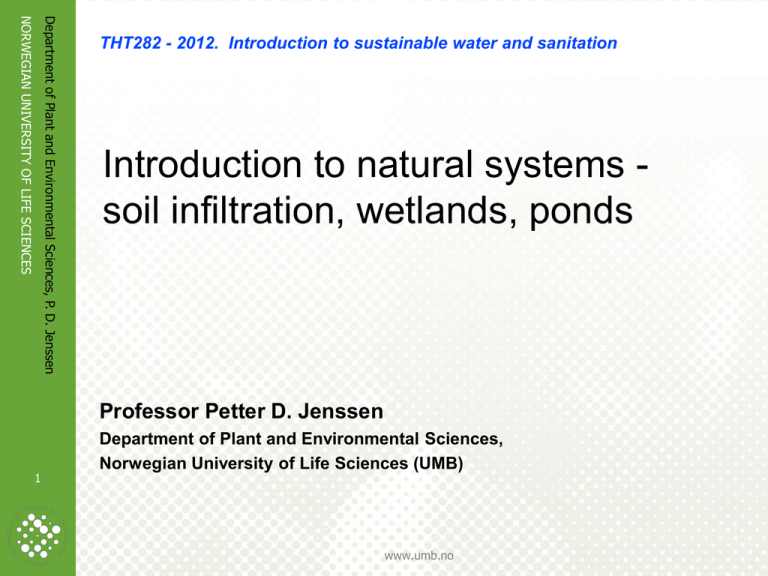
Department of Plant and Environmental Sciences, P. D. Jenssen NORWEGIAN UNIVERSITY OF LIFE SCIENCES THT282 - 2012. Introduction to sustainable water and sanitation Introduction to natural systems soil infiltration, wetlands, ponds Professor Petter D. Jenssen 1 Department of Plant and Environmental Sciences, Norwegian University of Life Sciences (UMB) www.umb.no NORWEGIAN UNIVERSITY OF LIFE SCIENCES Natural systems for wastewater treatment There are three main categories of natural systems, combinations between categories are also possible Ponds Infiltration Constructed wetlands www.umb.no Department of Plant and Environmental Sciences, P.D. Jenssen NORWEGIAN UNIVERSITY OF LIFE SCIENCES Natural systems can be gravity and sun driven and are thus energy extensive. Recycling can be enhances by reuse of P-saturated media Recycling Systems with source separation Energy intensive Energy extensive Natural systems; * Wetlands * Ponds * Soil infiltration Conventional systems 3 Loss www.umb.no NORWEGIAN UNIVERSITY OF LIFE SCIENCES Natural systems for wastewater treatment Ponds Infiltration Constructed wetlands www.umb.no Department of Plant and Environmental Sciences, P. D. Jenssen NORWEGIAN UNIVERSITY OF LIFE SCIENCES Soil infiltration systems Pretreatment 5 Infiltration unit called; leachfield or seepage bed/trenches www.umb.no NORWEGIAN UNIVERSITY OF LIFE SCIENCES Department of Plant and Environmental Sciences, P. D. Jenssen Traditional buried soil infiltration system 6 Siegrist et al. 2000 www.umb.no Department of Plant and Environmental Sciences, P.D. Jenssen NORWEGIAN UNIVERSITY OF LIFE SCIENCES Infiltration of wastewater into soil Open infiltration - dams Subsurface systems trenches/beds 7 www.umb.no Department of Plant and Environmental Sciences, P.D. Jenssen NORWEGIAN UNIVERSITY OF LIFE SCIENCES Infiltration of wastewater into soil AREA REQUIREMENT Open infiltration - dams 1-5m2/person Subsurface systems - trenches/beds 5-20m2/person 8 www.umb.no Department of Plant and Environmental Sciences, P.D. Jenssen NORWEGIAN UNIVERSITY OF LIFE SCIENCES Different buried infiltration systems Mound Surface infiltration Septic tank Shallow Deep infiltration infiltration Dosing device 9 Source: www.avlop.no www.umb.no NORWEGIAN UNIVERSITY OF LIFE SCIENCES Setermoen infiltration system 5000pe ONE PUMP IS THE ONLY MOVING PART IN THE WHOLE TREATMENT SYSTEM 66 THE INVESTMENT COST WAS 1/3 OF A CONVENTIONAL SYSTEM. PAYBACK TIME 7 YEARS www.umb.no Department of Plant and Environmental Sciences NORWEGIAN UNIVERSITY OF LIFE SCIENCES Fecal coli. 11 <100/100ml Treatment results rapid infiltration Norway COD Phosphorus www.umb.no Nitrogen (Kraft 1998) NORWEGIAN UNIVERSITY OF LIFE SCIENCES TREATMENT* Organic matter (COD): 75 - 90 % Suspended solids (SS): > 90% Phosphorus (P): >99 % Nitrogen (N) 50 - 70% Bacteria: Groundwater level 4-6 log reduction 12 *Renseeffekt i umetta sone ytterligere rensing foregår www.umb.no i grunnvanssonen. NORWEGIAN UNIVERSITY OF LIFE SCIENCES Setermoen infiltration system 5000pe ONE OF NORWAY´S BEST PERFORMING TREATMENT SYSTEMS 66 www.umb.no Department of Plant and Environmental Sciences, P.D. Jenssen NORWEGIAN UNIVERSITY OF LIFE SCIENCES Traditional buried soil infiltration system TREATMENT* Organic matter(BOD): > 90 % Suspended solids (SS): • > 90% Phosphorus (P): > 90 % Nitrogen (N) > 30% (20 - 60) Bacteria: 4-6 log reduction 14 (Siegrist et al. 2000) *Treatment preformance in the unsaturated zone, further treatment will occur in the saturated zone www.umb.no Department of Plant and Environmental Sciences, P.D. Jenssen NORWEGIAN UNIVERSITY OF LIFE SCIENCES Sandfilter Sloping sides Water level monitoring pipe • Geotextile/insulation Distribution layer Sand Bottom drainage (PDJ 1999) 15 PDJ 99 www.umb.no Department of Plant and Environmental Sciences, P.D. Jenssen NORWEGIAN UNIVERSITY OF LIFE SCIENCES Sandfilter - performance TREATMENT* Organic matter (COD): Septic tank effluent >90% Suspended solids (SS): > 90% Phosphorus (P)*: 0 - 80% Nitrogen (N) 30% (20 - 50%) Bacteria: Treated water 4-6 log reduction 64 16 * Based on 8 -10 years of operation www.umb.no www.umb.no Department of Plant and Environmental Sciences, P.D. Jenssen NORWEGIAN UNIVERSITY OF LIFE SCIENCES Subsurface infiltration - Mound system • Peilerør Water level monitoring pipes Sampling well Sand Natural soil PDJ 1999 17 www.umb.no Department of Plant and Environmental Sciences, P.D. Jenssen NORWEGIAN UNIVERSITY OF LIFE SCIENCES Mound system Mound systems are used when the depth of the local soil does not give sufficient separation distance to ground-water and in soils of low hydraulic conductivity 18 PDJ 1999 P.D.J. 1990 www.umb.no Department of Plant and Environmental Sciences, P.D. Jenssen NORWEGIAN UNIVERSITY OF LIFE SCIENCES Infiltration systems - treatment Shallow inflitration Mound Organic matter BOD Phosphorus Nitrogen (Køhler 1998) 19 www.umb.no Department of Plant and Environmental Sciences, P.D. Jenssen NORWEGIAN UNIVERSITY OF LIFE SCIENCES Subsurface infiltration - Mound system TREATMENT* • Peilerør Water level monitoring pipes Organic matter(BOD): > 90 % Suspended solids Sampling well (SS): Sand > 90% Phosphorus (P): > 90 % Natural soil Nitrogen (N) > 50 - 80 PDJ 1999 Bacteria: 20 4-6 log reduction www.umb.no Department of Plant and Environmental Sciences, P.D. Jenssen NORWEGIAN UNIVERSITY OF LIFE SCIENCES Different buried infiltration systems Mound Surface infiltration Septic tank Shallow Deep infiltration infiltration Dosing device 21 Source: www.avlop.no www.umb.no Department of Plant and Environmental Sciences, P.D. Jenssen NORWEGIAN UNIVERSITY OF LIFE SCIENCES From Siegrist 2010 22 Drip irrigation systems www.umb.no NORWEGIAN UNIVERSITY OF LIFE SCIENCES Department of Plant and Environmental Sciences, P.D. Jenssen Drip irrigation systems 23 www.umb.no NORWEGIAN UNIVERSITY OF LIFE SCIENCES Department of Plant and Environmental Sciences, P.D. Jenssen Drip irrigation systems From Siegrist 2010 24 www.umb.no Department of Plant and Environmental Sciences, P.D. Jenssen NORWEGIAN UNIVERSITY OF LIFE SCIENCES Drip irrigation systems - treatment Treatment Organic matter(BOD): > 90 % Suspended solids (SS): > 90% Phosphorus (P): > 90 % Nitrogen (N) > 30 - 70 % 25 From Siegrist 2010 Indicator bacteria: 4-6 log reduction www.umb.no Department of Plant and Environmental Sciences, P.D. Jenssen NORWEGIAN UNIVERSITY OF LIFE SCIENCES Drip irrigation systems - treatment Treatment Organic matter(BOD): > 90 % Suspended solids (SS): > 90% Phosphorus (P): > 90 % Nitrogen (N) > 30 - 70 % 26 From Siegrist 2010 Indicator bacteria: 4-6 log reduction www.umb.no Department of Plant and Environmental Sciences, P.D. Jenssen NORWEGIAN UNIVERSITY OF LIFE SCIENCES Drip irrigation systems - treatment Treatment Organic matter(BOD): > 90 % Suspended solids (SS): > 90% Phosphorus (P): > 90 % Nitrogen (N) > 30 - 70 % Indicator bacteria: 27 et al. 2010) 4-6 log(Conn reduction www.umb.no From Siegrist 2010 NORWEGIAN UNIVERSITY OF LIFE SCIENCES Natural systems for wastewater treatment Ponds Infiltration Constructed wetlands www.umb.no NORWEGIAN UNIVERSITY OF LIFE SCIENCES Department of Plant and Environmental Sciences, P.D. Jenssen Constructed wetland Dal primary school 29 www.umb.no Department of Plant and Environmental Sciences, P.D. Jenssen NORWEGIAN UNIVERSITY OF LIFE SCIENCES 30 www.umb.no flow direction/purification NORWEGIAN UNIVERSITY OF LIFE SCIENCES Department of Plant and Environmental Sciences, P.D. Jenssen Constructed wetland 31 High quality effluent www.umb.no Constructed wetland treating wastewater from 2 homes Septic tank Pretreatment biofilter (P Horizontal subsurface flow constructed wetland (HSF) Department of Plant and Environmental Sciences, P.D. Jenssen NORWEGIAN UNIVERSITY OF LIFE SCIENCES 33 Constructed wetland Dal primary school Parameter Influent Effluent mg/l mg/l Total - P 2,9 0,2 Total - N 29,0 12,0 COD 129 24 SS <5 Fecal. coli. /100ml < 2 www.umb.no Department of Plant and Environmental Sciences, P.D. Jenssen NORWEGIAN UNIVERSITY OF LIFE SCIENCES Reuse of P-saturated filter material 34 More information on reuse of filter media see: Jenssen et al.2010 www.umb.no Department of Plant and Environmental Sciences, P.D. Jenssen NORWEGIAN UNIVERSITY OF LIFE SCIENCES Constructed wetland - performance TREATMENT* Organic matter(BOD): > 90 % Suspended solids (SS): > 90% Phosphorus (P): > 90 % Nitrogen (N) 105 Designed accoding to Norwegian regulations (VA-miljøblad no. 49) the service life for P-removal is expected to be 10-15 years www.umb.no > 40 - 60 Bacteria: >3 log reduction NORWEGIAN UNIVERSITY OF LIFE SCIENCES Natural systems for wastewater treatment Ponds Infiltration Constructed wetlands www.umb.no Ponds are the worlds most common treatment system Photo: W. Browne Department of Plant and Environmental Sciences, P.D. Jenssen NORWEGIAN UNIVERSITY OF LIFE SCIENCES 38 Photo: W. Browne www.umb.no The worlds largest wastewater treatment system ? NORWEGIAN UNIVERSITY OF LIFE SCIENCES Department of Plant and Environmental Sciences, P.D. Jenssen Calcutta wetlands 39 www.umb.no The primary pond NORWEGIAN UNIVERSITY OF LIFE SCIENCES Department of Plant and Environmental Sciences, P.D. Jenssen Calcutta wetlands 40 www.umb.no Department of Plant and Environmental Sciences NORWEGIAN UNIVERSITY OF LIFE SCIENCES Calcutta wetlands 84 41 Provides 15 - 20% of the fresh fish in Calcutta markets www.umb.no Ponds function in cold climate if aerated (Jenssen et al. 1991) Aeration cascade Photo: W. Browne Typical removal: * BOD * Nitrogen * Phosphorus 60 - 90% 20 - 40% 10 - 30% Photo: W. Browne Treatment Organic matter(BOD): > 60 - 90 % Suspended solids (SS): Typical removal: * BOD * Nitrogen * Phosphorus 60 - 90% 20 - 40% 10 - 30% 80 - 90% Phosphorus (P): 10 - 30 % Nitrogen (N) > 30 - 70 % Indicator bacteria: 2-6 log reduction Photo: W. Browne Department of Plant and Environmental Sciences NORWEGIAN UNIVERSITY OF LIFE SCIENCES A pond/wetl and system in Norway 148 www.umb.no Department of Plant and Environmental Sciences NORWEGIAN UNIVERSITY OF LIFE SCIENCES A pond/wetl and system in Norway Parameter Effluent conc. mg/l Removal % TOC 5 93 TSS <5 < 90 Total - P 0.24 96 Total - N 4 91 148 Fecal Coli. /100ml <100 >99.999 www.umb.no Department of Plant and Environmental Sciences NORWEGIAN UNIVERSITY OF LIFE SCIENCES Removal in a pond/wetl and system in Norway Parameter Norway´s best performing treatment system? Effluent conc. mg/l Removal % TOC 5 93 TSS <5 < 90 Total - P 0.24 96 Total - N 4 91 148 Fecal Coli. /100ml <100 >99.999 www.umb.no More information see: Browne and Jenssen 2005 Department of Plant and Environmental Sciences, P.D. Jenssen NORWEGIAN UNIVERSITY OF LIFE SCIENCES 48 Wastewater Treatment Natural systems - processes Biological mineralization Chemical/physical precipitation/adsorption Physical straining/filtering www.umb.no Groundwater Department of Plant and Environmental Sciences, P.D. Jenssen NORWEGIAN UNIVERSITY OF LIFE SCIENCES Removal mechanisms in natural systems • • • • Removal of organic matter Removal of phosphorus Removal of microorganisms Removal of nitrogen 49 www.umb.no Department of Plant and Environmental Sciences, P.D. Jenssen NORWEGIAN UNIVERSITY OF LIFE SCIENCES Reduction of organic matter Plastic particles as biofilm carrier K1 K2 d= 9 mm 50 d= 15 mm Natrix O d= 60 mm Biofilm media surface area 310 - 500 m2/m3 www.umb.no Kaldnes TM Department of Plant and Environmental Sciences, P.D. Jenssen NORWEGIAN UNIVERSITY OF LIFE SCIENCES 51 Reduction of organic matter Expanded clay aggregates (FiltraliteHCTM) as biofilm carrier Particle size 2-5mm Surface area > 5000m2/m3 Bacteria on Filtralite surface www.umb.no Department of Plant and Environmental Sciences, P.D. Jenssen NORWEGIAN UNIVERSITY OF LIFE SCIENCES 52 Reduction of organic matter Porous media as biofilm carrier Sand Filtralite Particle size 0.06 - 2 mm Particle size 2-5mm Surface area > 5000m2/m Surface area >> 5000m2/m www.umb.no Purification through sand NORWEGIAN UNIVERSITY OF LIFE SCIENCES Department D ‹ epartment of Plant and Environmental Sciences, P.D. Jenssen Septic tank effluent Treated water 53 www.umb.no Department of Plant and Environmental Sciences, P.D. Jenssen NORWEGIAN UNIVERSITY OF LIFE SCIENCES Removal mechanisms in natural systems • • • • Removal of organic matter Removal of phosphorus Removal of microorganisms Removal of nitrogen 54 www.umb.no Phosphorus removal in soils Organic layer, Ohorizon Oxidized layer, Bhorizon Subsoil, Chorizon Phosphorus removal in soils Fe3(PO4)2 AlPO4 Ca3(PO4)2 NORWEGIAN UNIVERSITY OF LIFE SCIENCES Department of Plant and Environmental Sciences, P.D. Jenssen Phosphorus forms in soil - dependent on pH 57 (From Brady 1990) www.umb.no Groundwater level Department of Plant and Environmental Sciences NORWEGIAN UNIVERSITY OF LIFE SCIENCES Fecal coli. 59 <100/100ml Treatment results rapid infiltration Norway COD Phosphorus www.umb.no Nitrogen (Kraft 1998) P-sorption capacity: 14 years under each basin Groundwater level Department of Plant and Environmental Sciences, P.D. Jenssen NORWEGIAN UNIVERSITY OF LIFE SCIENCES Phosphorus removal in soils depth of infiltration trenches Organic layer, Ohorizon Oxidized layer, Bhorizon 62 Subsoil, Chorizon www.umb.no Department of Plant and Environmental Sciences, P.D. Jenssen NORWEGIAN UNIVERSITY OF LIFE SCIENCES Removal mechanisms in natural systems • • • • Removal of organic matter Removal of phosphorus Removal of microorganisms Removal of nitrogen 63 www.umb.no • NORWEGIAN UNIVERSITY OF LIFE SCIENCES Department of Plant and Environmental Sciences, P.D. Jenssen Small buried infiltration systems (Siegrist et al. 2000) 64 www.umb.no Department of Plant and Environmental Sciences, P.D. Jenssen NORWEGIAN UNIVERSITY OF LIFE SCIENCES Pit toilets 65 A: Traditional pit latrine. B: VIP-latrine and C: pour flush toilets with twin soakpits. www.umb.no Department of Plant and Environmental Sciences, P.D. Jenssen NORWEGIAN UNIVERSITY OF LIFE SCIENCES 66 Infiltration systems bacteria removal Soil surface Depth cm Infiltration trench Bacteria/100ml or 100g of soil E coli Cloggede zone Total coli Total bacteria (McCoy and Ziebell 1975) www.umb.no NORWEGIAN UNIVERSITY OF LIFE SCIENCES Department of Plant and Environmental Sciences, P.D. Jenssen The fate of microorganisms in soil 67 www.umb.no Department of Plant and Environmental Sciences, P.D. Jenssen NORWEGIAN UNIVERSITY OF LIFE SCIENCES Straining 68 The fate of microorganisms in soil www.umb.no Department of Plant and Environmental Sciences, P.D. Jenssen NORWEGIAN UNIVERSITY OF LIFE SCIENCES Size of soil pores vs. size of microorganisms Macropores Pore sizes in sand Virus Bacteria Parasites 69 ( Edworthy 1979 in Englund 1980) www.umb.no Predation NORWEGIAN UNIVERSITY OF LIFE SCIENCES Department of Plant and Environmental Sciences, P.D. Jenssen The fate of microorganisms in soil 70 www.umb.no Adsorption NORWEGIAN UNIVERSITY OF LIFE SCIENCES Department of Plant and Environmental Sciences, P.D. Jenssen The fate of microorganisms in soil 71 www.umb.no NORWEGIAN UNIVERSITY OF LIFE SCIENCES Department of Plant and Environmental Sciences, P.D. Jenssen The fate of microorganisms in soil Death by old age 72 www.umb.no Department of Plant and Environmental Sciences, P.D. Jenssen NORWEGIAN UNIVERSITY OF LIFE SCIENCES Removal mechanisms in natural systems • • • • Removal of organic matter Removal of phosphorus Removal of microorganisms Removal of nitrogen 73 www.umb.no Department of Plant and Environmental Sciences NORWEGIAN UNIVERSITY OF LIFE SCIENCES Fecal coli. 74 <100/100ml Treatment results rapid infiltration Norway COD Phosphorus www.umb.no Nitrogen (Kraft 1998) NORWEGIAN UNIVERSITY OF LIFE SCIENCES Department of Plant and Environmental Sciences, P.D. Jenssen Nitrogen transformations in soils 75 (Jenssen and Siegrist modified after Lance 1972) www.umb.no Ammonification NORWEGIAN UNIVERSITY OF LIFE SCIENCES 76 www.umb.no ammonium ----> NH4 NH2 urea Department of Plant and Environmental Sciences, P.D. Jenssen Nitrogen transformations in soils Department of Plant and Environmental Sciences, P.D. Jenssen NORWEGIAN UNIVERSITY OF LIFE SCIENCES Nitrogen transformations in soils Nitrification NH4 --> NO2--> NO3 ammonium 77 www.umb.no nitrite nitrate Department of Plant and Environmental Sciences, P.D. Jenssen NORWEGIAN UNIVERSITY OF LIFE SCIENCES Nitrogen transformations in soils Nitrification NH4 --> NO2--> NO3 ammonium nitrite nitrate Prerequisite: Aerobic conditions 78 www.umb.no Department of Plant and Environmental Sciences, P.D. Jenssen NORWEGIAN UNIVERSITY OF LIFE SCIENCES Nitrogen transformations in soils Denitrification NO3 --> N2O --> N2 nitrate nitrous oxide nitrogen gas Prerequisites biological denitrification: 79 1. Anerobic or anoxic conditions 2. Carbon source www.umb.no Department of Plant and Environmental Sciences, P.D. Jenssen NORWEGIAN UNIVERSITY OF LIFE SCIENCES Traditional buried soil infiltration system Ammonification • Nitrification Denitrification 80 Denitrification (Siegrist et al. 2000) www.umb.no NORWEGIAN UNIVERSITY OF LIFE SCIENCES Department of Plant and Environmental Sciences, P.D. Jenssen Constructed wetland 81 www.umb.no Denitrification Nitrification NORWEGIAN UNIVERSITY OF LIFE SCIENCES Department of Plant and Environmental Sciences, P.D. Jenssen Constructed wetland 82 www.umb.no Department of Plant and Environmental Sciences, P.D. Jenssen NORWEGIAN UNIVERSITY OF LIFE SCIENCES 83 Natural systems Conclusions Natural systems can be designed in many different ways to accommodate local conditions Natural systems require relatively large area per person Natural systems have stable and high treatment performance Natural systems are simple in design, robust and cost efficient The phosphorus removal of soil infiltration type systems and constructed wetlands is dependent on the P-removal capacity of the porous media www.umb.no Department of Plant and Environmental Sciences, P.D. Jenssen NORWEGIAN UNIVERSITY OF LIFE SCIENCES 84 References Browne, W. og P.D. Jenssen (2005). Exceeding tertiary standards with a pond/reed bed system in Norway. Wat. Sci. Tech. 51(9), 299–306. Conn KE, Siegrist RL, Barber LB, Meyer MT. 2010. Fate of Trace Organic Compounds during Vadose Zone Soil Treatment in an Onsite Wastewater System. J. Environmental Toxicology and Chemistry. 29(2):285-293. Published online 8 October 2009. DOI:10.1002/ etc.40 Jenssen, P. D., T. Krogstad A. M. Paruch T. Mæhlum, K. Adam, C. A. Arias, A. Heistad, L. Jonsson, D. Hellström, H. Brixd M. Yli-Halla, L. Vråle, M. Valve. 2010. Filter bed systems treating domestic wastewater in the Nordic countries – performance and reuse of filter media. Ecol. Eng. 36, pp. 16511659. Jenssen, P.D. og R.L. Siegrist (19). Nitrogen removal from wastewater in soil infiltration systems. I: H. Ødegaard (red.): Fjerning av nitrogen i avløpsvann, 114– 12. Tapir. Trondheim Lance, J.C. (1972). Nitrogen removal by soil mechanisms. J. Water Poll. Control Fed. 44(7), 1552–1561 McCoy, E. og Z.A. Ziebell (1975). Effects of effluents on ground water, bacteriol- ogical aspects. 2nd Conf. on individual on-site wastewater systems. National Sanitation Foundation, Ann Arbor, Michigan, 67–76. Siegrist R.L. 2010. Effluent Dispersal into Soil for Treatment and Disposal/Reuse: Principles and Practices Sustainable Sanitation. Presentation at the summerschool: Decentralized, Natural and Ecological Wastewater Treatment, Department of Plant and Environmental SciencesThe Norwegian University of Life Sciences June 1 - 25, 2010 Siegrist RL. 2007. Engineering Soil Treatment Units as a Unit Operation in Onsite Wastewater Reclamation Systems. Proc. 11th National Symposium on Individual and Small Community Sewage Systems, Warwick, RI, October 21-24, 2007, American Society of Agricultural and Biological Engineers, St. Joseph, MI. Siegrist, R. L., E.J. Tyler og P.D. Jenssen (2000). Design and performance of onsite wastewater soil absorption systems. Paper presented at National Research Needs Conference Risk-Based Decision Making for Onsite Wastewate Treatment, St. Luis, Missouri, 19.–20. mai. USEPA, Electic Power Inst. Community Env. Center, National Decentralized Water Recources Capasity Development Conference Risk-Based Decision Making for Onsite Wastewate Treatment, St. Luis, Missouri, 19.–20. mai. USEPA, Electic Power Inst. Community Env. Center, National Decentralized Water Recources Capasity Development Project. www.umb.no
